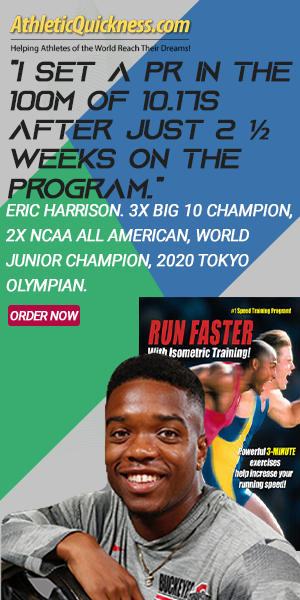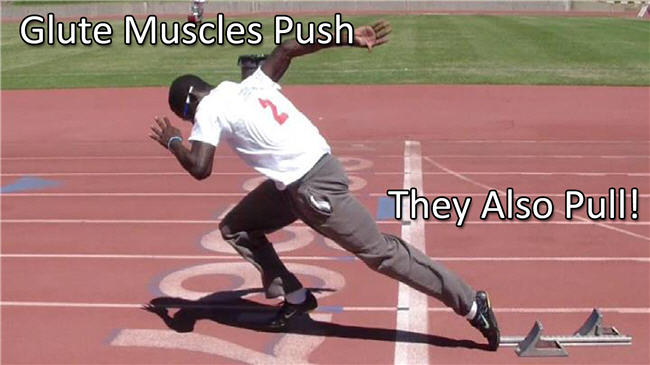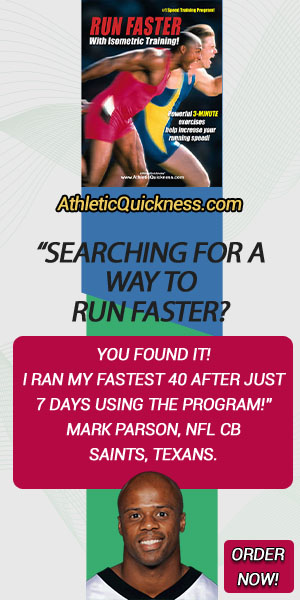The Glutes –
How to get the advantage in a game situation!
The Glutes are often conditioned for pushing and jumping, yet they are mostly under-developed for pulling.
If you haven’t figured it out by now, I’m a huge fan of what the hip flexor muscles can do for any athlete desiring speed, power and instant playmaking ability.
I am also convinced beyond a shadow of a doubt that many athletes unwittingly ignore the power stored up in this muscle group and can go through their entire playing careers never reaching their absolute best.
All you need to do is read through a few pages as well as a few testimonials on this site to find this out.
But in this article, I will discuss the antagonistic, or opposite, muscle group to the hip flexors and those are the hip extensors. The hip extensors, more specifically, consist of all three of your gluteal muscles, (gluteus maximus, gluteus medius and gluteus minimus) and all three of your hamstring muscles (semimembranosus, semitendinosus, and the long head of the biceps femoris. The short head of the biceps femoris does not cross the hip joint and therefore does not cause any hip extension.)
The hip extensors get most of the exercise and attention when it comes to training for speed from many trainers and coaches.
There are many reasons for this, and one of them is because these muscles are so easily targeted in most gym settings by way of the standard equipment available (squat racks, leg curl machines) as well as other popular exercises like deadlifts. This accessibility leads to their popularity.
The other reason is because the hip extensors are often associated with the main power and driving force during the initiation of movement in the running process.
During this motion, the thigh is posterior to the hip and the only real motion the leg can supply to the body is by pushing.
This pushing motion is driven by the hip extensor muscles and because it is the main muscle group involved at the start of a race or sprint, the importance for training them is certainly well deserved.
Now you can learn more about the push phase of the running and hip extensor muscles by signing up for my free 4 part video series on getting faster in any sport.
But, here is something you may not have known?
Did you know that the hip extensors can and are also called into action through a PULLING phase in both running and walking?
You bet they are!
Whenever your thigh is anterior, or in front of your hip or waistline, and your foot is on the ground, the same hip extensor muscles that provided the push now have to pull your thigh and leg behind you so that they can eventually push again as the running process repeats itself.
But, you say, so what?
Well, when athletes are looking for every competitive edge they can get over their opponent, doesn’t it make sense to train your muscles to perform for all of the motions and movements that they will be required to do?
Of course it does. So, let me ask you this:
What exercises are you doing now to train your hip extensor muscles to PULL, not PUSH, yourself forward?
Can I take a wild guess? How about none?
Squats don’t train the hip extensors for this pulling motion of running and neither to leg curls, deadlifts, leg press machines.
So, my next wild guess is that not only are most athletes weak in their hip flexors from lack of exercise, they are perhaps even weaker when it comes to involving the hip extensors in any pulling motion.
Is this a problem?
It depends on how serious of an athlete you desire to be. If you want to be average and just be a part of a team and get in towards the end of the game when the outcome is all but certain, I suppose you can overlook ALL of the PULLING exercises that your hip extensors are involved in.
But if you are looking to excel at your sport, dominate your opponent, and make the headlines in your local newspaper and get that Division I scholarship, then you may have just found one more muscle that not only needs improvement, but one that can also provide significant improvement to your game.
Now the good news is that there are several fundamentally sound hip extensor exercises found in the RUN FASTER, JUMP HIGHER, KICK FARTHER and other speed and quickness training programs offered on this site.
I also have a few extra, more advanced exercises, that I give to serious athletes once they make a purchase, and I also provide specific advice through video about how to finely tune these exercises for maximum speed, quickness and athletic advantage.
[sc name=”2step-optin”]
If you are serious about getting faster and quicker, then get serious about training your hip extensors not just for the push phase of running, but also for the PULLING PHASE OF RUNNING.
Not only will the pulling motion of your hip extensors help increase your running speed, it will also help you get off to a quick start from a standing position. Getting a quick start is crucial in all most all sports that require speed.
Now, you can also learn more about the Pull Phase in the Free 4 part video series on getting faster I mentioned earlier.
Those videos are designed to call your attention to the importance of these muscles and to make you totally aware that if you want to excel in your sport, you need to excel in your training first.
Now, you will have to purchase a speed training program to get these game breaking exercises and when you do, I will know you are serious about getting faster and taking your game to the next level.
I will also give you 100% of me and my team’s support when you place an order for any of the exercise programs I previously mentioned.
Remember, your competition is looking for the same types of advantages you are and they are relentless in their pursuit. You too, need to get serious about your training.
Now I’m going to leave you with a question and answer I heard the other day:
“When is a good thing a bad thing?”
“When it keeps you from the BEST thing!”
Don’t be satisfied with just another good speed training workout in the gym. Desire the best speed training workout you can have, and that means training your muscles for every possible athletic movement and situation that game situations present.
[sc name=”runfaster testimonial banner – green”]
[sc name=”Order Here Button-01″]
Always glad to help!
Dr. Larry Van Such






